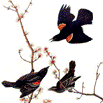Wildlife Damage Management, Internet Center for
Document Type
Article
Date of this Version
September 1968
Abstract
The balanced approach is essential for the proposed application of control methods for birds. The essential ingredients in a balanced approach are knowledge of the environment, both animal, plant and human; reasonable experience in the solution of biological problems; and an awareness of the possible solutions available. After these problems' qualifying ingredients have been met, the control specialist or investigator may apply the tool of choice. In most instances he will have selected alternatives available to himself. In the selection of the tool of choice and alternative methods, the cost of time, labor, materials and equipment, the need or purpose of the control, and the effect upon the public or clientele are all involved. Careful attention to the consideration of all of these factors is essential in providing sufficient alternatives as well as the tool of choice. Safety must be considered as an integral part of the operation and not as a a separate item. Managerial evaluation which does not include safety as an integral part of the control operation invariably violates certain basic rules of safety, sometimes with unpleasant consequences. The tool of choice and secondary or alternative methods and their reasons for their relative priority should be discussed in lay terms with specialists or clientele involved. Final decisions on methods too frequently result in exposing the ignorance of individuals. Therefore, it is essential that the clientele understand the reasoning processes involved in the selection of the method used. Major areas of use for pyrotechnics and non-electronic audio-repellents are difficult to delineate; they generally are: (1) when the need for control is ephe-meral or short-lived; (2) when the labor or equipment costs of alternative methods are high (the material costs are less important); (3) when a bird roost needs to be moved to a location where it may be attacked by better methods; (4) when lethal methods cannot be used for a variety of reasons; (5) where disruption of a business or industrial operation is inconvenient and the fire hazard is low (I am generally not talking of pigeon problems; I'm speaking of pyrotechnic use in the case of starlings, blackbirds, or other birds with a high social structure); (6) where other methods, particularly detergents, have proved unsatisfactory in moving birds from a roost


